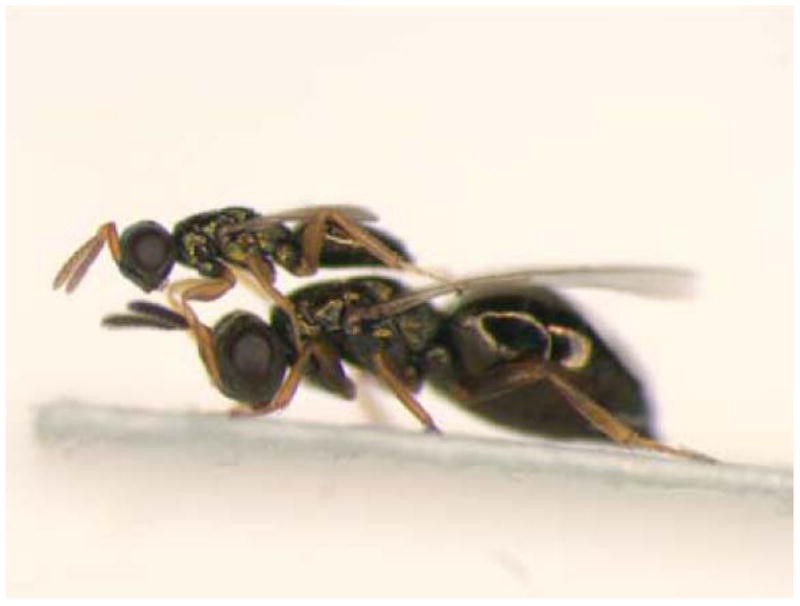Musca domestica is a vital vector organism with worldwide distribution, generally controlled by chemical control, physical control, and environmental treatment as the main methods. When Musca domestica pupates, it usually looks for hidden places and pupates under shallow soil, which is difficult to kill effectively, it is the most challenging stage for Musca domestica to control, and it is difficult for general pesticides to achieve the effect. Nasonia vitripennis belongs to Hymenoptera, Pteromalidae family, and is a Diptera fly pupal stage-specific parasitoid wasp, which has a good control effect on Musca domestica.
 Figure 1.Nasonia vitripennis male and female engaged in courtship. (Werren, J. H., Loehlin, D. W., 2009)
Figure 1.Nasonia vitripennis male and female engaged in courtship. (Werren, J. H., Loehlin, D. W., 2009)
Nasonia vitripennis has the potential to be robustly expanded to target critical genes. Lifeasible can be used for RNA silencing via RNA interference (RNAi) or gene knockout via CRISPR/Cas9 genome editing. This allows you to functionally analyze genes of interest in Nasonia vitripennis to study a wide range of important biological phenomena in this organism.
| Methods | Descriptions |
| CRISPR/Cas9 | We could have generated independent heritable germline mutations against the conserved eye pigmentation gene cinnabar using the CRISPR/Cas9 system. |
| RNAi | The white pupal stage of Nasonia vitripennis is suitable for RNAi-mediated knockout experiments. Double-stranded RNA (dsRNA) can be injected into female nymphs to knockout genes in offspring embryos. The adult red-eye phenotype can be obtained by injecting dsRNA targeting the eye color gene cinnabar in larvae. RNAi tools can also be used to discover haploid genes on the B chromosome and to study the relationship between the clock gene period and biological rhythms. |

Since Nasonia vitripennis eggs require a pupal host to develop, handling eggs during gene editing is very challenging. We use embryos collected from the host Musca domestica pupa, rapidly microinjected, and immediately transferred back to the host for development. These steps our scientists are precisely and specifically trained to avoid damaging the microinjected embryos or the pupal host.
With the increasing use of Nasonia vitripennis as a model organism for solving various biological problems, Lifeasible is also actively developing and optimizing injection methods to provide simplified and efficient protocols for functional analysis of the Nasonia vitripennis gene. Please feel free to contact us with your needs, and we will assess the feasibility and customize a technical solution for you.